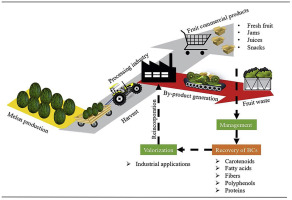Trends in Food Science & Technology ( IF 15.1 ) Pub Date : 2020-03-27 , DOI: 10.1016/j.tifs.2020.03.033 Ricardo Gómez-García , Débora A. Campos , Cristóbal N. Aguilar , Ana R. Madureira , Manuela Pintado

|
Background
For modern food industry, sustainability of food processing is a major concern coupled to the reduction of waste generation. Fruit and vegetable processing require of modernization to valorize the waste and by-products highly generated, particularly because they are rich in natural beneficial components which are demanded to human health. Melon (Cucumis melo L.) processing generate a high amount of peels and seeds, which are recognized with higher content of bioactive compounds than pulp, including polyphenols, carotenoids and oils.
Scope and approach
In this review, we summarize information about of the bioactive compounds present in the melon fruit, together with the nutritionals properties that it presents as a functional food, with a focus on its by-products (pulp, seed and peel). The melon fruit contains important bioactive compounds, mainly the peel has a high content of antioxidants which are of interest in the food, cosmetic and pharmaceutical industries. These findings pretend to support new research concerning the formulation of novel functional foods based on melon by-products.
Key finding and conclusions
Extracts of melon fruit, mainly from the peel, have been shown to possess phytochemical compounds that exhibit antioxidant, antimicrobial, antidiabetic, antiviral, anti-inflammatory, anti-hypoglycemia and anti-proliferative effects in various in vitro and in vivo test. However, it is necessary for further analyze the nutritional and functional potential of these by-products, the therapeutic and clinic mechanisms involved and to develop its industrial process as functional or nutraceutical food products.
中文翻译:

甜瓜果实(Cucumis melo L.)副产品的增值:植物化学和生物功能特性,重点是近期趋势和进展
背景
对于现代食品工业而言,食品加工的可持续性是减少废物产生的主要考虑因素。水果和蔬菜加工需要现代化,以使大量产生的废物和副产品保持价值,特别是因为它们富含人体健康所需的天然有益成分。甜瓜(Cucumis melo L.)加工产生大量的果皮和种子,这些果皮和种子的生物活性化合物含量高于果肉,包括多酚,类胡萝卜素和油。
范围和方法
在这篇综述中,我们总结了有关瓜果中存在的生物活性化合物的信息,以及其作为功能食品所呈现的营养特性,重点是其副产品(纸浆,种子和果皮)。甜瓜果实含有重要的生物活性化合物,主要是果皮具有高含量的抗氧化剂,在食品,化妆品和制药行业中受到关注。这些发现假装支持有关基于瓜副产品的新型功能食品配方的新研究。
关键发现和结论
已显示,主要从果皮中提取的瓜果提取物具有植物化学化合物,这些化合物在各种体外和体内试验中均表现出抗氧化,抗微生物,抗糖尿病,抗病毒,抗炎,抗低血糖和抗增殖的作用。但是,有必要进一步分析这些副产品的营养和功能潜力,涉及的治疗和临床机制,并发展其作为功能性或营养食品的工业生产过程。











































 京公网安备 11010802027423号
京公网安备 11010802027423号